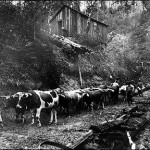
Redwood Creek – The Embarcadero Redwood City
In the 1851’s there was a strong demand for redwood lumber for the building of San Francisco. The Redwood trees were harvested in Woodside, Ca and hauled down to Portola Road and milled into lumber. Once the trees were milled into lumber it was hauled by wagon down Woodside Road to the Embarcadero in Redwood City. This lumber was loaded on barges and sent to San Francisco to build what today we call Victorian homes and some older commercial structures too.
Today Redwood City’s original waterfront is a memory. Both of the old tidal basins south of Bradford Street changed over to culverts and channelized and serves today’s needs. Some buildings on Main Street and Broadway, dating from the waterfront’s active days, still stand and mark the limits of the old sloughs. Most of the inner and outer basins have become parking lots and/or parking garages. When built there were issues with flooding during rainy winter days. Redwood Creek had the last say and we had to succumb to its wishes and figure out another way to protect us from it.
Dr. R. O Tripp discovered that Redwood Creek had possibilities for shipping when he and his friends dragged logs here with oxen teams, lashed them together as rafts, and floated them to San Francisco for use as wharf pilings. G.W. Burnham laid the keel for the schooner, “Redwood” here in 1851. Launched in December of 1852, the first in a series of similar vessels built for the lumber industry. By 1853, a village with wharves, blacksmith shops and a store clustered around a slough that filled and emptied with the flow and ebb of the tides. This creek connected the sawmills to the West with the Bay and river delta system and the gold rush towns and cities within its reaches. The Embarcadero consisted of two basins. Lumber and other materials used the outer basin where the water was deep enough at high tide to float cargo-laden schooners. Shipbuilding used the inner basin, where the channel was shallower. Construction of a fixed bridge at Broadway in 1868 ended ship building in the inner basin. This event marked the beginning of a trend of moving waterfront activities closer to the Bay. Decline of shipping through the Embarcadero began with completion of the San Francisco and San José Railroad in 1864. The railroad was a competitor for all kinds of shipping, but bulk product transportation still favored the less expensive, though slower schooners. Shoaling of the creek, exhaustion of timber resources, and a shift from shallow draft to deeper draft ships. Brought an end to Redwood City’s old waterfront by 1915. Jeffrey D. Rhoads.
Past use: Ship building, lumber products, shipping and storage, waterfront activities
Present use: Parking lots, governmental use, and commercial use
Original use: Waterfront, bulk transfer and storage
If you find this information helpful and would like to make Redwood City your home you can do so by clicking on the orange button on the right. You will then receive daily the homes that come on the market for sale on the local MLS for free. The homes will be only the homes that meet your criteria and meet what is important to you. There is no cost or obligation for this service. We would like to show why you would want Cliff Keith and Team in your corner when you do decide to buy your new home.
Tags: bulk transfer and storage, commerance, draft ships, Redwood Creek, San Francisco, sfbayhomes.com, The Embarcadero, Waterfront, wood mills, wood to build san francisco, woodside ca
